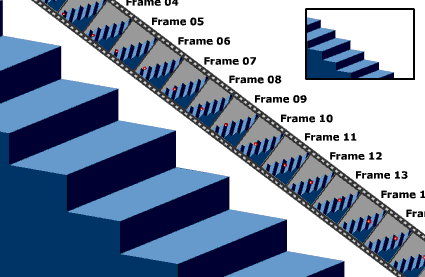What is Instructional Animation?
Moving images that show motion to illustrate a key point, such as how a part rotates.
How Can I Use Instructional Animations?
First, determine whether animations will help further your learning objectives.
Consider the following:
- Do you need to teach a physical skill?
- Do you need to reproduce a lifelike movement? If so, is video too costly to produce, or is the situation too dangerous to use live actors?
- Do you need to show a change over time?
If any of these are true, then an animation may be called for. Once you decide you need an animation, here are some questions you should ask yourself. Do you need:
- a sense of perspective, (e.g., relative size, speed, and path of motion to some other object).
- the ability to convey the time or motion-based aspects of animation, such as a time lapse to illustrate a flower opening.
- user control, so the user can replay the animation and/or examine it from different angles, perspectives, or environments.
- clarity of representation, where labels or other cueing devices might be included in the animation to make clear a process.
For simple animations that do not require user control, there is a special type of GIF file known as an animated GIF or GIF89a that may provide the animation you need.
Animated GIFs are formally called multi-block GIFs because multiple images can be stored as separate blocks within one single GIF document. This is very much the same as cel-based animation, where each frame in the animation is slightly different from the one preceding it. When the GIF document is viewed, the multiple images display, quickly and in succession, and produce a streaming animation. There are many simple GIF animation creation programs freely available.
Here is an example of an animated GIF showing how each frame is displayed in a consecutive sequence.

Other animation tools exist, but possess a steep learning curve.
How Can You Obtain Assistance Developing Instructional Animations?
Check with your local instructional designer and also the Penn State Media Commons at http://mediacommons.psu.edu.
What References Are There About Instructional Animations?
131 Tips on Graphics and Animations for eLearning. (2013). Santa Rosa, CA: The eLearning Guild. Retrieved December 1, 2020, from http://www.elearningguild.com/publications/index.cfm?id=36
Clark, R., & Lyons, C. (2011). Graphics for learning: Proven guidelines for planning, designing, and evaluating visuals in training materials (2nd ed.). San Francisco: Pfeiffer.
- Also available online as a Graphics for Learning eBook via the Penn State Libraries at https://catalog.libraries.psu.edu/catalog/29285080
Rieber, L. & Boyce, M. (1990). The effects of computer animation on adult learning and retrieval tasks. Journal of Computer Based Instruction, 17, 46-52.
Siliauskas, G. (1986). Effective use of computer graphics in CAI: A review of the literature. Canadian Journal of Educational Communications, 5, 75-84.